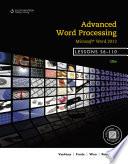Written for a diverse audience (all ages, different educational backgrounds, varying educational goals), this book allows for self-paced or online learning. The primary goal of the GO! Series: Microsoft Word 2003 Brief Edition is to teach Microsoft Word 2003 quickly and easily, with an approach that is based on clearly-defined projects. A key feature of the book is the use of Microsoft procedural syntax: steps begin with where the action is to take place, followed by the action itself. The instruction is error-free, clearly written, and logically arranged. This book provides users with the skills to solve business problems using the computer as a tool. Beginning with a comprehensive overview of Word 2003, the book covers getting started with Word, using special utilities and formatting tools, and adding clip art and tables. For anyone interested in learning the ins and outs of Microsoft Word 2003.
Written for a diverse audience (all ages, different educational backgrounds, varying educational goals), this book allows for self-paced or online learning.








